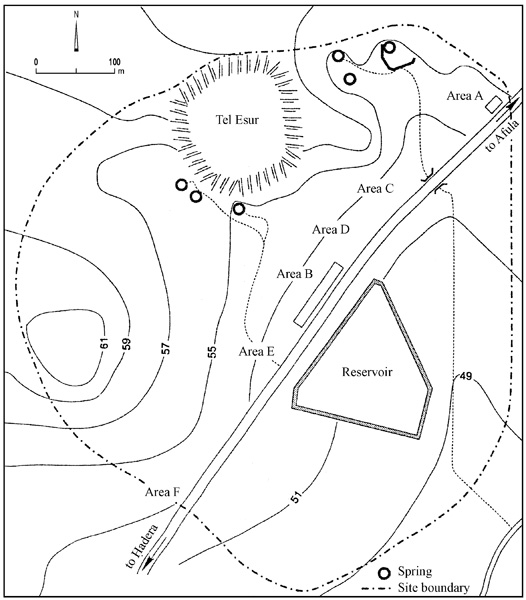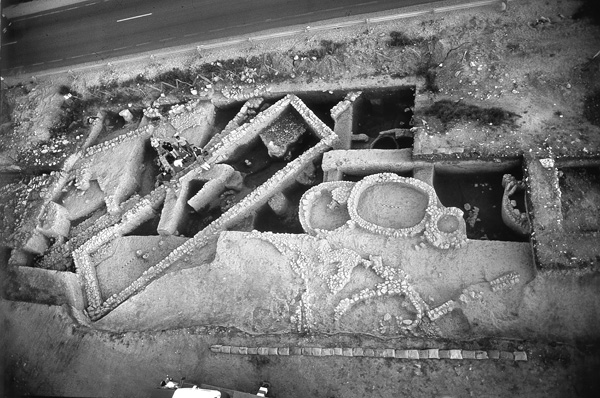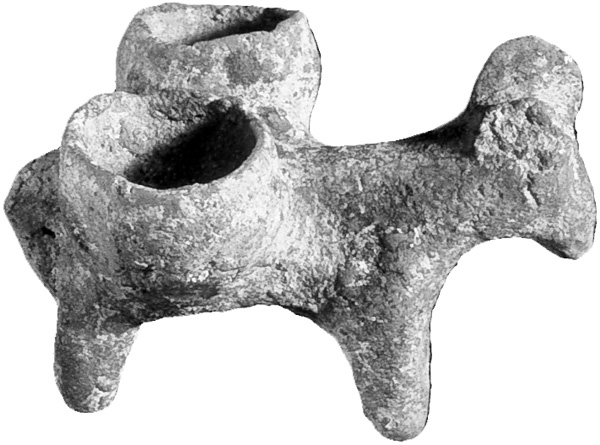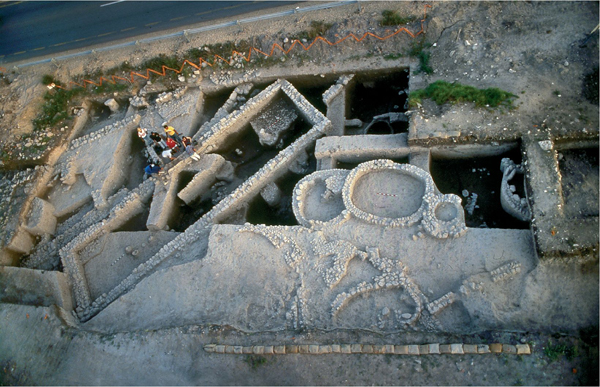Esur, Tel
THE SITE
Tel Esur (Tell el-Asawir) is situated at the southern entrance to
EXCAVATIONS
In 1953, M. Dothan excavated a tomb slightly east of the Barkai Junction dating to the Early and Middle Bronze Ages. In 1956, R. Gophna and V. Sussman excavated a burial cave from the Middle and Late Bronze Ages located within the precincts of Kibbutz Barkai. A rich tomb from the Late Bronze Age and a small tomb from the Early Bronze Age I were excavated by members of the kibbutz; neither tomb was published and the finds were stolen from the kibbutz during the 1960s. In 1996–1997, E. Yannai and Z. Horowitz excavated tombs in the eastern cemetery: 2 from the Early Bronze Age IB and 20 dating from the Early Bronze Age IV. In 1999, E. Yannai excavated a Late Bronze Age tomb, 6 Early Bronze Age IV tombs, and a tomb dating from the Late Bronze Age IB in the southern cemetery.
In 1994 and 1999, E. Yannai conducted an extensive excavation at the prehistoric site on behalf of the Israel Antiquities Authority. In 2000–2004, A. Zertal excavated the tell on behalf of the University of Haifa.
THE PREHISTORIC SITE
The areas and strata uncovered at the prehistoric site are summarized as follows:
| Area A | Area B | Area C | Area D | Area E | Area F | Area G | |
|---|---|---|---|---|---|---|---|
| Early Bronze IB | I | II | I | I | I | I | I–III |
| Early Bronze IA | III | IV | |||||
| Late Chalcolithic | IV | V | |||||
| Chalcolithic | Va | ||||||
| Early Chalcolithic | Vb–c | ||||||
| Wadi Rabah culture | II | VI | II | II | VI | ||
| Pottery Neolithic A | VII |
AREA A. Area A is located east of the tell, next to the Barkai Junction. Pottery sherds of the Wadi Rabah culture and the Early Bronze Age IB were exposed in the area. Most of its antiquities were destroyed during the construction of the National Water Carrier.
AREA B. Seven superimposed settlement strata were revealed in area B, located south of the tell.
Stratum VII. Stratum VII yielded several Pottery Neolithic A (Jericho IX culture) sherds exposed in an extremely marshy soil layer.
Stratum VI—The Wadi Rabah Culture. Mainly living surfaces without architecture were exposed in stratum VI. Finds characteristic of the Wadi Rabah culture include small slingstones, dark-faced burnished ware sherds, rim sherds from bow-rim jars, incised and punctured decorations in different geometric designs, and short, denticulated flint blades.
Stratum Vb–c—The Early Chalcolithic Period. Living surfaces, tabuns, and stone floors were revealed in stratum Vb–c. Ceramics dating to the early Chalcolithic period were exposed on the floors. Among the finds recovered are basalt and stone vessels, and light-colored pottery sherds adorned with an abundance of dark red decorations. The flint implements typical of this assemblage include axes, adzes, tabular scrapers, and denticulated sickle blades. This early Chalcolithic culture parallels the Qatifian and Besorian cultures in the northern Negev and those of Tel

Stratum Va—The Chalcolithic Period. A broad wall, 30 m long, was exposed in stratum Va. The wall was widened with offsets in several spots and forms an obtuse angle at its midpoint. A sloping stone glacis meets the front of the wall. No other walls or structures were found in the area. The excavators believe the wall demarcated the perimeter of the settlement. Pottery sherds and flint items characteristic of the late Chalcolithic period were exposed on the floors abutting the inside of the wall.
Stratum IV—The Late Chalcolithic Period. An entire building was exposed in stratum IV, as well as half of another building surrounded by a number of courtyards and surfaces. In the former a complete doorway, with a stone socket and stone steps, was revealed in situ. Two phases were discerned in each of the buildings. Benches were attached to their walls. Among the pottery vessels recovered are V-shaped bowls with red slipped rim, chalices, kraters, basins, jars, pithoi, and fragments of churns and coronets. Also found were stone and basalt vessels, a number of stone figurines, flint adzes and axes, and a copper axe.
Stratum III—The Early Phase of the Early Bronze Age I. Several elliptical stone buildings and stone-paved alleys were uncovered. In and around the buildings were found pottery, basalt, and other stone vessels and flint implements typical of the Early Bronze Age I. Especially noteworthy is the large number of the early type of knobbed gray burnished ware bowls.
Stratum II—The Later Phase of the Early Bronze Age I. A number of rectangular buildings were exposed. While their inner corners form 90-degree angles, outer corners are rounded. A circular building and an alley were uncovered on the eastern side of the excavation area. Alterations were discerned in all of the buildings and the alley, floors were raised, several walls were renovated, and changes were made in the settlement’s plan. Pottery sherds typical of the later phase of the Early Bronze Age I were found associated with the buildings.
AREA D. A unique corridor building from the late phase of the Early Bronze Age IB was exposed, containing a number of pithoi and jars with bow rims. Below the building was a layer of the Wadi Rabah culture.
AREA G. Six strata were exposed in area G. The upper three layers are of the Early Bronze Age IB. Below them are two Early Bronze Age IA layers. Below these strata and the buildings is a stratum that yielded Chalcolithic sherds, below which is a level with Wadi Rabah sherds.

THE CEMETERIES
The excavations in the cemeteries around ‘Ein Asawir have focused until now upon three locations on the chalk ridges along the eastern and southern edges of the settlement. Most of the tombs date to the time of the very large settlement from the Early Bronze Age IB and Early Bronze Age IV and only three tombs are ascribed to the period of the settlement on the tell (from the Middle Bronze Age IIA until the Byzantine period).
THE EASTERN CEMETERY. The eastern cemetery extends east of the tell and the prehistoric settlement located to its west, and to the south of the tell. In 1959, M. Dothan excavated a tomb of the Early Bronze Age IB and the Middle Bronze Age, c. 500 m to the east of the tell. In 1995, E. Yannai excavated tomb 1, c. 50 m west of that excavated by M. Dothan, exposing finds from the Early Bronze Age IB under remains from the Early Bronze Age IV. In 1996, E. Yannai and Z. Horowitz excavated two Early Bronze Age IB tombs (tombs 3 and 20), and 20 Early Bronze Age IV tombs (tombs 2
The Early Bronze Age IB Tombs. Tomb 3 was exposed next to the tomb excavated by M. Dothan. In it were found hundreds of vessels from the Early Bronze Age IB. The ceramic assemblage includes hemispherical and shallow bowls, gray burnished carinated bowls, various kinds of jars and amphoriskoi, jugs, and juglets. In the upper part of the tomb were exposed a number of pottery vessels from the transitional phase to the Early Bronze Age II. Petrographic studies have revealed that among the vessels exposed in the tomb were several from the Yarkon River basin and the Samaria Hills, as well as an imported Egyptian bottle. Along with the pottery vessels were a bronze dagger blade and several hundred limestone and semi-precious beads from Egypt.
Tomb 20 lies c. 50 m northeast of tomb 3. In it was found an assemblage of locally produced vessels identical to those uncovered in the tomb excavated by M. Dothan and in tomb 3. Alongside the locally produced vessels were vessels from the Samaria Hills, imported bottles from both the Orontes River basin in Syria and from Egypt, as well as a unique goblet imported from southeastern Anatolia. Together with the pottery vessels were hundreds of imported Egyptian carnelian beads.

The Early Bronze Age IV Tombs. Twenty shaft tombs of the Early Bronze Age IV were exposed. The shafts are square or round in shape, c. 1.20 m in diameter and up to 3 m deep. Most of the tombs are dome-shaped and divided into two or three burial chambers. In one case four burial chambers were revealed. Most of the chambers are hewn and are either rounded or irregular in shape. The finds in the tombs include a range of pottery vessels: bowls, several types of jars, amphoriskoi, jugs, and cooking pots. One group of amphoriskoi is decorated with a few vertical red painted stripes, but for the most part the vessels are unpainted. Most of the jars and amphoriskoi have a spherical body; the bowls, some of the jars and amphoriskoi, jugs, and teapots have a flat base. A single decorative line is incised on the neck of some of the vessels. The group of vessels from the tombs of the eastern cemetery is related to the vessels from Mount Carmel, the Manasseh Highlands, and the western fringes of the Jezreel Valley.

Together with the pottery vessels were found several bronze spearheads and flint implements. In some of the tombs only a single sickle blade was found, in others only a bronze spearhead, and in some only pottery vessels. Pottery vessels were found together with a spearhead in only one tomb.

THE SOUTHERN CEMETERY. The southern cemetery is located on a chalk ridge c. 0.5 km from the southern fringes of the settlement and 1 km from the eastern cemetery. Nine tombs were exposed in the cemetery: one from the Early Bronze Age I (tomb 45), one from the Early Bronze Age II (tomb 40), five from the Early Bronze Age IV (tombs 42
Tomb 45 of the Early Bronze Age I contained 187 pottery vessels very similar to the vessels from tombs 3 and 20 of the eastern cemetery. Especially noteworthy are a vertical twin vessel and a figurine of a donkey laden with jars. A number of imported Egyptian pottery vessels and a red-painted incense stand imported from the Lebanese coast were also found in this tomb. Tombs from the Early Bronze Age IV in the southern cemetery were quarried in the same manner and with the same dimensions as the Early Bronze Age I tombs in the eastern cemetery; in the former, however, the quality of the rock cutting is careless and the finished rock surfaces are rough. Pottery vessels were found in situ in three of the tombs. The pottery assemblage consists of only one bowl, three globular jars, several types of amphoriskoi, jugs, and teapots. Two spearheads with sockets and a bronze ridged dagger were found in tomb 48. These implements are typical of the Middle Bronze Age II, but no pottery vessels were found in that tomb, leaving its date in question.
Tomb 41 of the Late Bronze Age lies in the westernmost point of the cemetery. In it were found scores of locally produced pottery vessels alongside white slip II bowls, base-ring ware, and vessels imported from the Syrian-Lebanese coast. With them were found a number of carnelian beads, glass, and colored stones. On the basis of the Cypriot pottery vessels, the tomb is dated to the thirteenth century BCE.
CONCLUSIONS
The first settlement at Tel Esur was established next to the spring in the Pottery Neolithic A period. During the period of the Wadi Rabah culture, the settlement extended over hundreds of dunams and covered the area of the hills to the east, south, and west of the abundant spring; no architectural remains from this period were exposed. The settlement continued uninterrupted during each phase of the Chalcolithic period. Settlement remains of this period were exposed in areas B and G only, located several hundred meters apart. Thus, while the size of the Chalcolithic period settlement was rather extensive, it was smaller than that of the Wadi Rabah and Early Bronze Age IB settlements. Characteristic of the end of the Chalcolithic period is a fine quality, delicate type of ceramic found to date only at Asherat in western Galilee.
The settlement area during the Early Bronze Age IA was somewhat reduced, though in the later phase of the Early Bronze Age IB it returned to its dimensions when it was at its largest. Based on evidence found in the tombs of this period, the residents of ‘Ein Asawir were well-off and engaged in commerce with Egypt, the Lebanese coast, the ‘Amuq Valley, and eastern Anatolia. While Early Bronze Age II strata were not revealed in the excavations, remains from that period were found in tomb 40, and a number of pottery sherds typical of the period were collected in a survey of the site.
At the beginning of the Middle Bronze Age II, new residents arrived at the site. They constructed a trapezoidal rampart along the northern side of the settlement, next to the springs, thus forming an artificial mound approximately 10 a. in area. In excavations of the settlement above the rampart, Middle Bronze Age II, Late Bronze Age, and Persian period strata were encountered. Iron Age sherds were only found on the small mound southwest of the tell and it seems that the ancient tell was uninhabited during the Iron Age. Along the southern fringes of the tell’s summit were found remains dating from the Roman and Byzantine periods; there may have been an isolated farm there. After the abandonment of the site, it was not resettled until the end of the Ottoman period, when a khan was constructed on the mound at the foot of the tell. The khan was sporadically inhabited by nomadic Bedouin until the end of the British Mandate.
ELI YANNAI
Color Plates

THE SITE
Tel Esur (Tell el-Asawir) is situated at the southern entrance to
EXCAVATIONS
In 1953, M. Dothan excavated a tomb slightly east of the Barkai Junction dating to the Early and Middle Bronze Ages. In 1956, R. Gophna and V. Sussman excavated a burial cave from the Middle and Late Bronze Ages located within the precincts of Kibbutz Barkai. A rich tomb from the Late Bronze Age and a small tomb from the Early Bronze Age I were excavated by members of the kibbutz; neither tomb was published and the finds were stolen from the kibbutz during the 1960s. In 1996–1997, E. Yannai and Z. Horowitz excavated tombs in the eastern cemetery: 2 from the Early Bronze Age IB and 20 dating from the Early Bronze Age IV. In 1999, E. Yannai excavated a Late Bronze Age tomb, 6 Early Bronze Age IV tombs, and a tomb dating from the Late Bronze Age IB in the southern cemetery.
